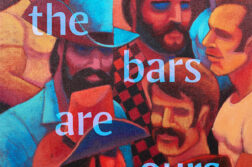IN 1967, Nicola De Bartolo appeared before Italy’s Supreme Court of Cassation. She was appealing a conviction for “wearing a mask in a public place.” Unbeknownst to De Bartolo, her case would mark a watershed moment in Italian legal history. It would be cited frequently to justify the repression, surveillance, incarceration, and even deportation of queer people in Italy throughout the 1960s and ’70s.
Something was strange about De Bartolo’s conviction for “wearing a mask in a public place.” De Bartolo was not wearing a mask at the time of the arrest. Instead, she was dressed in a blouse, “a skirt, nylon tights, women’s shoes, long hair, make-up, painted nails” and carried a “woman’s purse”—but no mask. The lower court found De Bartolo guilty of mascheramento, or “mask-wearing,” because her material dress obscured her “natural” biological sex. Because De Bartolo was biologically male, the Court found, her typically “feminine” dress made it impossible to recognize “him.” For the lower court, this alleged obfuscation amounted to a criminal act. The Supreme Court of Cassation affirmed.
Why were Italians prohibited from wearing masks? And why was De Bartolo’s gender expression conflated with wearing one? The answer lies in a little-known Fascist law that hadn’t been enforced for decades: Article 85.
During Italy’s Fascist period, Mussolini’s legal regime aimed to blur the lines between the public and the private, regulating individual expression, and justifying the state’s intrusion into the private sphere by citing public safety and morality. El Duce’s Minister of Justice, Alfredo Rocco, revised Italy’s penal code to make it manifestly more authoritarian. Article 85 was found in a selection of articles regulating stage performance: “Appearing masked in public is prohibited. The offender may be arrested and will be fined between 100 and 1000 lire. The use of masks in theatres and other areas open to the public is prohibited. … Violators and people who do not remove the mask upon the request of law enforcement officers may be arrested and punished.”
When Nicola De Bartolo appeared before the Supreme Court of Cassation, they argued that mascheramento laws should be read literally as prohibitions against wearing face coverings in public. The Court disagreed with this interpretation, broadly reading the article as a protection against those who obscure their identity to engage in criminal activity and elude law enforcement. Because De Bartolo was dressed “as a woman,” the Court found, they were not readily recognizable and therefore a threat to public safety. The Court’s reasoning grew out of the expansion of the definition of a “mask” over time. Initially, mascheramento laws did aim to regulate wearing physical masks in public, and its roots reach as far back as the early Middle Ages, from the famously mask-centered tradition of Carnival.
Carnival was one of the few times of year that medieval Italians were permitted to wear masks. It was a break from the established social order. Gambling, violence, sexual transgression, and blasphemy were ubiquitous during the festival. Furthermore, masked subjects were considered dangerous because they were unidentifiable and could commit these criminal acts, among others, with impunity. Although masks were permitted during certain hours of Carnival, legislative decrees prohibiting mask-wearing outside of festival times proliferated. Violators may have been fined or undergone corporal punishment.
During the Fascist period, the definition of a “mask” was expanded. After a group of parading masked people were prosecuted under Article 85, the Supreme Court of Cassation found that “any alteration of the face that makes a person more or less unrecognizable to police agents, even if not impeding the ability of relatives or acquaintances to recognize him, contradicts the substance of Article 85. … Therefore, the use of make-up on one’s face … falls within the bounds of this prohibition.” This reasoning laid the groundwork for the punishment of queer people in the postwar period.
As the Sexual Revolution took off in Italy in the late 1960s and homosexuality became more visible, the government increased its efforts to regulate public morality and decency, creating a new police division dedicated to policing the boundaries of acceptable expression and behavior. Arrests under Article 85 followed. Police and politicians continued to cite the bland justification that Article 85 was intended to prevent masked individuals from getting away with crime. But as queer people began to gather more frequently and in greater numbers, the police raided their community spaces and nightclubs, seizing makeup, wigs, and clothing. There were many others like Nicola De Bartolo. Queer people described spending nights in jail, being deported out of big cities, facing curfews, and surviving police brutality for being queer and trans.
Nevertheless, they persisted. Queer Italians founded community advocacy organizations, staging protests and crafting networks of support and care. Leading queer figures wrote prolifically. One such figure, Mario Mieli, argued that the true mask was that of heterosexuality. “From our vantage point,” he wrote, “it is ‘normal’ people who are the true transvestites,” hiding their true, “marvelous” human nature behind “standard outfits.”
Italy’s Article 85 has never been repealed, so it is technically still in force despite many attempts to abrogate the law in its entirety.
Amanda Madigan is a third-year student at Harvard Law School.




